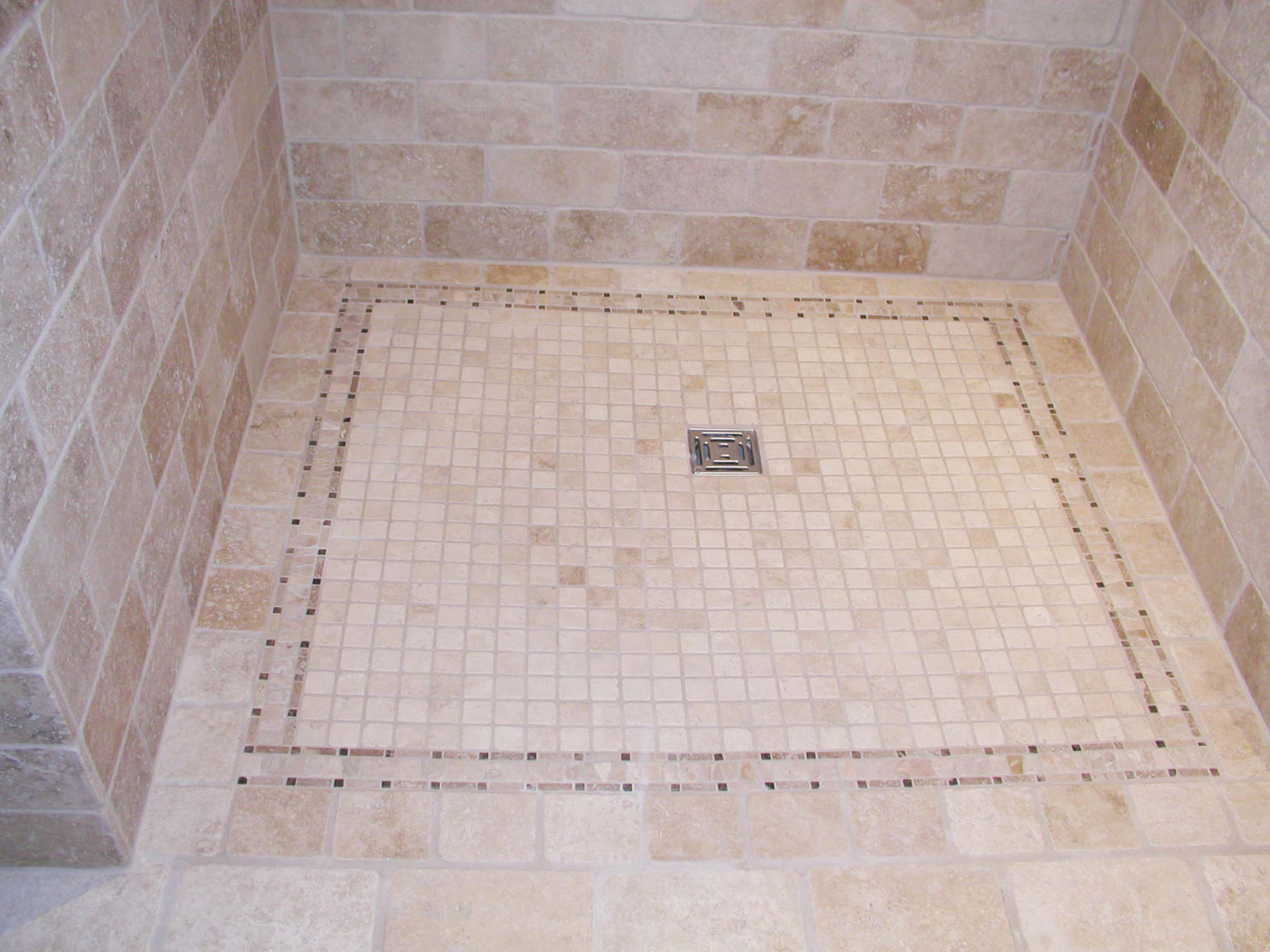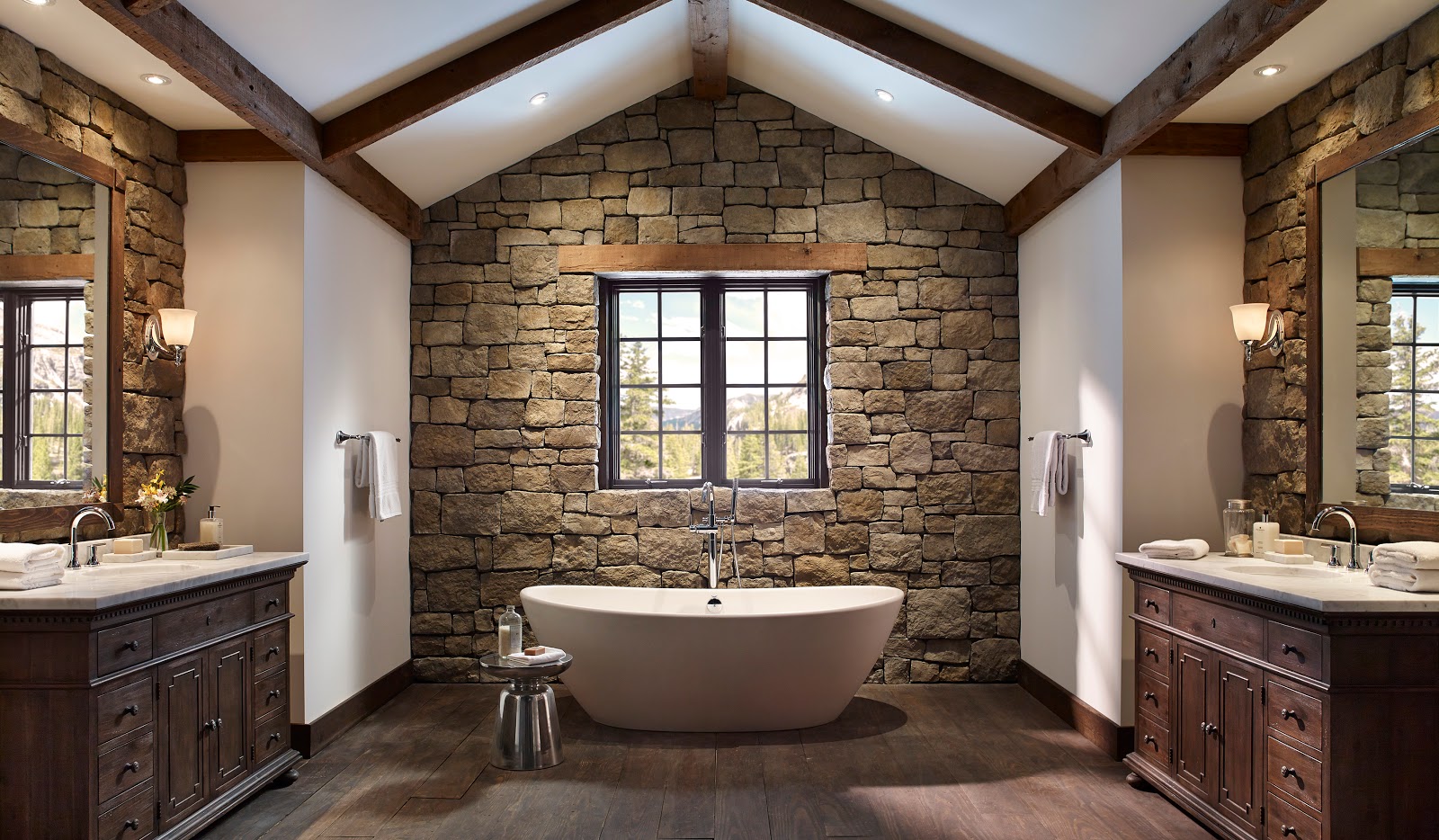Design Inspiration & Styles

Stacked stone bathroom design offers a unique blend of natural beauty and modern functionality, transforming ordinary spaces into captivating oases. The versatility of stacked stone allows for a wide range of design styles, from rustic and farmhouse to contemporary and modern, each adding its own distinct character to the bathroom environment.
Stacked Stone Materials
Stacked stone is available in a variety of materials, each offering distinct visual and functional qualities.
- Natural Stone: Natural stone, such as slate, granite, marble, and limestone, brings a timeless elegance and authentic touch to bathroom designs. These stones come in diverse colors, textures, and patterns, creating a unique and visually appealing focal point.
- Manufactured Stone: Manufactured stone, often referred to as faux stone, provides a cost-effective alternative to natural stone while mimicking its aesthetic appeal. It’s lightweight, durable, and available in a wide array of colors, textures, and patterns, making it a versatile option for various design styles.
- Tile: Stacked stone tile, often made from ceramic or porcelain, offers a more affordable and practical choice for bathroom designs. It comes in various sizes, shapes, and finishes, allowing for creative and visually impactful wall designs.
Visual Impact of Stacked Stone Colors and Textures
The choice of stacked stone colors and textures plays a crucial role in shaping the overall ambiance and visual impact of the bathroom.
- Light vs. Dark: Light-colored stacked stone, such as white, beige, or cream, creates a sense of spaciousness and brightness, reflecting light and making the bathroom feel larger. Darker stones, like black, gray, or brown, add a sense of drama and sophistication, creating a more intimate and cozy atmosphere.
- Smooth vs. Rough: Smooth stacked stone surfaces, such as polished marble or smooth tile, offer a sleek and modern aesthetic, reflecting light and creating a polished look. Rougher textures, like tumbled stone or rustic slate, add a sense of warmth and rustic charm, creating a more natural and earthy feel.
Stacked Stone Accent Wall Design
Creating a stacked stone accent wall in the bathroom is a popular design choice, adding a unique visual element and enhancing the space’s overall appeal.
- Layout Patterns: Stacked stone accent walls can be designed using various layout patterns, including running bond, stacked bond, and herringbone, each offering a distinct visual appeal. Running bond, the most common pattern, creates a simple and linear look, while stacked bond creates a more modern and geometric feel. Herringbone, with its zig-zag pattern, adds a touch of sophistication and visual interest.
- Color Schemes: The color scheme of the stacked stone accent wall should complement the overall bathroom design. For a modern and minimalist aesthetic, consider using neutral colors like gray, white, or black. For a rustic or farmhouse style, warm tones like brown, beige, or cream are ideal.
Practical Considerations & Application

Stacked stone, with its rustic charm and enduring appeal, can elevate your bathroom’s aesthetic. However, before embarking on this design journey, it’s crucial to consider the practical implications of incorporating stacked stone in this moisture-prone environment.
Moisture Resistance and Cleaning
Stacked stone, despite its inherent beauty, requires careful consideration regarding moisture resistance and cleaning. Some stone types, like natural stone, are inherently porous and can absorb moisture, potentially leading to mold growth. Others, like porcelain or ceramic, offer greater resistance. The application of a sealant, a protective layer that inhibits water penetration, is crucial for all stacked stone installations in bathrooms. Regular cleaning with a mild detergent and water is essential to maintain the stone’s luster and prevent grime buildup.
Cost Comparison of Stacked Stone Materials and Installation Methods
The cost of stacked stone can vary significantly based on the material and installation method. Natural stone, like slate or marble, tends to be more expensive than manufactured alternatives, such as porcelain or ceramic. Installation costs also vary, with professional installation typically exceeding DIY efforts.
- Natural Stone: The most expensive option, natural stone like slate or marble, offers a unique, timeless aesthetic. However, its porous nature necessitates sealing and careful maintenance.
- Manufactured Stone: Porcelain and ceramic stacked stone offer a more affordable alternative to natural stone, with a wider range of colors and textures. They are also more moisture-resistant and require less maintenance.
- DIY Installation: Installing stacked stone yourself can save on labor costs, but it requires time, patience, and basic DIY skills.
- Professional Installation: Hiring a professional ensures a seamless and aesthetically pleasing installation, but comes at a higher cost.
Choosing the Right Stacked Stone for Different Bathroom Areas
Selecting the right stacked stone for your bathroom depends on the area’s function and aesthetic goals.
- Shower Walls: For shower walls, moisture-resistant options like porcelain or ceramic are ideal. Their non-porous nature makes them easier to clean and less susceptible to mold growth.
- Accent Walls: Accent walls offer an opportunity for bolder design choices. Natural stone, with its unique veining and textures, can create a stunning focal point. However, remember to seal it properly for protection.
- Vanities: Stacked stone can add a touch of elegance to vanities. For this application, consider using smaller tiles or thin stacked stone panels for a less overwhelming effect.
Step-by-Step Guide to Installing Stacked Stone Tiles
Installing stacked stone tiles requires a few essential tools and steps:
- Prepare the Wall: Clean the wall surface thoroughly and apply a primer for better adhesion.
- Apply Mortar: Spread a thin layer of mortar on the wall using a trowel.
- Install Tiles: Press the stacked stone tiles firmly against the mortar, ensuring they are level and aligned.
- Space Tiles: Use spacers to maintain consistent grout lines.
- Grout: Once the mortar has set, apply grout to fill the spaces between the tiles.
- Clean Excess Grout: Wipe away excess grout with a damp sponge.
- Seal: Apply a sealant to protect the stacked stone from moisture and stains.
Stacked Stone Bathroom Features & Ideas: Stacked Stone Bathroom Ideas

Stacked stone offers a unique and versatile way to add character and texture to your bathroom. From accent walls to shower surrounds, the possibilities are endless. This section explores the diverse ways you can incorporate stacked stone into your bathroom design, creating a truly unique and stylish space.
Stacked Stone Bathroom Design Ideas
Stacked stone can be used in various ways to elevate your bathroom’s aesthetic. Here are some popular ideas:
- Accent Walls: A stacked stone accent wall adds a dramatic focal point to the bathroom. It can be used to highlight a freestanding tub, a vanity, or a specific area of the room. The stone’s natural texture and color variations create visual interest and depth.
- Shower Surrounds: Stacked stone shower surrounds offer a luxurious and durable option. The stone’s natural properties resist moisture and mold, making it an ideal choice for a wet environment. The variety of stone types and finishes allows for a customized look that complements the bathroom’s overall style.
- Backsplashes: A stacked stone backsplash adds a touch of rustic elegance to the bathroom. It can be used behind the sink, the bathtub, or even around a vanity mirror. The stone’s natural texture and color variations create a unique and eye-catching focal point.
- Fireplace Surrounds: For bathrooms with a fireplace, stacked stone provides a timeless and elegant surround. The stone’s natural warmth complements the fireplace’s ambiance, creating a cozy and inviting atmosphere.
Examples of Stacked Stone Bathroom Designs, Stacked stone bathroom ideas
Stacked stone seamlessly blends with various bathroom design elements, creating a cohesive and stylish space.
- Freestanding Tubs: A stacked stone accent wall behind a freestanding tub creates a spa-like retreat. The stone’s natural texture and color variations complement the tub’s sleek lines, adding a touch of luxury and sophistication.
- Walk-in Showers: Stacked stone shower surrounds add a touch of rustic elegance to walk-in showers. The stone’s natural properties resist moisture and mold, making it an ideal choice for a wet environment. The variety of stone types and finishes allows for a customized look that complements the bathroom’s overall style.
- Floating Vanities: Stacked stone backsplashes behind floating vanities add a touch of sophistication and depth. The stone’s natural texture and color variations create a unique and eye-catching focal point, complementing the vanity’s minimalist design.
Bathroom Lighting Options for Stacked Stone
Proper lighting plays a crucial role in highlighting the beauty of stacked stone. Consider these options:
| Lighting Option | Description | Effect on Stacked Stone |
|---|---|---|
| Pendant Lights | Suspended from the ceiling, pendant lights provide focused illumination over specific areas. | Pendant lights cast dramatic shadows and highlight the stone’s texture and color variations. |
| Sconces | Wall-mounted sconces offer ambient lighting and create a warm and inviting atmosphere. | Sconces accentuate the stone’s natural beauty, creating a soft and diffused glow. |
| Recessed Lighting | Flush-mounted in the ceiling, recessed lighting provides even and diffused illumination. | Recessed lighting enhances the stone’s texture and color variations, creating a balanced and modern look. |
Color and Texture in Stacked Stone Bathrooms
Color and texture play a crucial role in creating a cohesive and stylish stacked stone bathroom.
- Color: The color of the stacked stone should complement the overall color scheme of the bathroom. For example, warm-toned stones like beige or brown can create a cozy and inviting atmosphere, while cool-toned stones like gray or blue can create a more contemporary and sophisticated look.
- Texture: The texture of the stacked stone can add depth and visual interest to the bathroom. Smooth stones create a sleek and modern look, while rough stones add a rustic and organic feel.